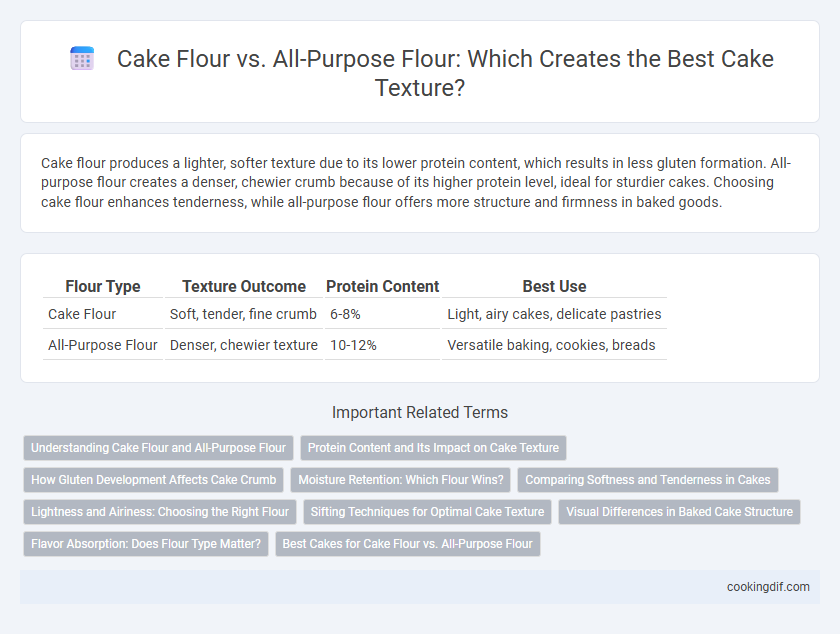Cake flour produces a lighter, softer texture due to its lower protein content, which results in less gluten formation. All-purpose flour creates a denser, chewier crumb because of its higher protein level, ideal for sturdier cakes. Choosing cake flour enhances tenderness, while all-purpose flour offers more structure and firmness in baked goods.
Table of Comparison
| Flour Type | Texture Outcome | Protein Content | Best Use |
|---|---|---|---|
| Cake Flour | Soft, tender, fine crumb | 6-8% | Light, airy cakes, delicate pastries |
| All-Purpose Flour | Denser, chewier texture | 10-12% | Versatile baking, cookies, breads |
Understanding Cake Flour and All-Purpose Flour
Cake flour contains lower protein content, usually around 7-8%, resulting in a finer, softer texture ideal for delicate cakes and tender crumb structures. All-purpose flour has a higher protein content, typically 10-12%, offering more gluten development that produces denser, chewier baked goods suitable for a variety of recipes. Understanding these differences helps bakers choose the right flour to achieve the desired texture, soft and airy with cake flour or more structured and firm with all-purpose flour.
Protein Content and Its Impact on Cake Texture
Cake flour contains about 7-9% protein, significantly lower than all-purpose flour's 10-12%, resulting in a finer, softer crumb ideal for delicate cakes. The lower protein content in cake flour limits gluten formation, producing a tender and light texture that prevents toughness. In contrast, all-purpose flour's higher protein yields more gluten, leading to denser, chewier cakes not suitable for recipes requiring a soft, airy crumb.
How Gluten Development Affects Cake Crumb
Cake flour contains less protein (about 7-9%) compared to all-purpose flour (10-12%), resulting in lower gluten formation and a finer, tender crumb. Reduced gluten development in cake flour creates a softer, more delicate texture ideal for light cakes, while all-purpose flour produces a denser crumb due to stronger gluten networks. Controlling gluten development directly impacts cake crumb structure, moisture retention, and overall mouthfeel.
Moisture Retention: Which Flour Wins?
Cake flour excels in moisture retention due to its lower protein content, which results in a finer, softer crumb that stays moist longer compared to all-purpose flour. All-purpose flour's higher gluten levels can lead to a denser texture and faster moisture loss in cakes. For recipes prioritizing maximum moisture and tenderness, cake flour is the preferred choice.
Comparing Softness and Tenderness in Cakes
Cake flour contains less protein (about 7-8%) compared to all-purpose flour (10-12%), resulting in a finer, softer crumb and enhanced tenderness in cakes. The lower gluten content in cake flour produces a delicate texture ideal for light, fluffy cakes, whereas all-purpose flour yields a denser, chewier outcome. Using cake flour improves cake softness by creating a more tender structure that easily traps air during mixing and baking.
Lightness and Airiness: Choosing the Right Flour
Cake flour has a lower protein content, typically around 7-9%, which results in less gluten formation and contributes to a lighter, airier texture in baked goods. All-purpose flour contains higher protein levels, usually 10-12%, producing a denser crumb and chewier texture. For cakes requiring a delicate, soft crumb, cake flour is the preferred choice to achieve optimal lightness and airiness.
Sifting Techniques for Optimal Cake Texture
Sifting cake flour multiple times aerates the flour, eliminating lumps and ensuring uniform particle size, which contributes to a lighter, more delicate cake crumb. All-purpose flour benefits equally from sifting to break up denser granules and improve gluten distribution, but its higher protein content may still yield a firmer texture compared to cake flour. Consistent sifting techniques directly influence the final cake texture by promoting even mixing and optimal rise during baking.
Visual Differences in Baked Cake Structure
Cake flour produces a finer, more delicate crumb with a tender and uniform texture, while all-purpose flour results in a denser, coarser structure with larger air pockets. The lower protein content in cake flour allows for less gluten formation, creating a smoother, tightly knit visual appearance in the crumb. Cakes baked with all-purpose flour typically exhibit a more robust, uneven texture and a slightly rougher surface.
Flavor Absorption: Does Flour Type Matter?
Cake flour's fine texture and lower protein content enable it to absorb flavors more effectively, resulting in a tender, moist crumb with enhanced taste. All-purpose flour, with a higher protein level, provides more structure but can sometimes inhibit the delicate flavor absorption needed for light, fluffy cakes. Choosing cake flour optimizes flavor infusion and smooth texture, crucial for delicate baked goods.
Best Cakes for Cake Flour vs. All-Purpose Flour
Cake flour's lower protein content and finer texture create lighter, softer cakes with tender crumb, ideal for delicate desserts like sponge cakes and chiffon cakes. All-purpose flour provides more structure and a denser crumb, making it suitable for sturdier cakes such as pound cakes and layer cakes that benefit from a firmer texture. Choosing cake flour enhances fluffiness and moisture retention, while all-purpose flour offers flexibility for a wide range of cake styles.
Cake flour vs All-purpose flour for texture Infographic

 cookingdif.com
cookingdif.com